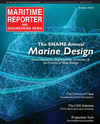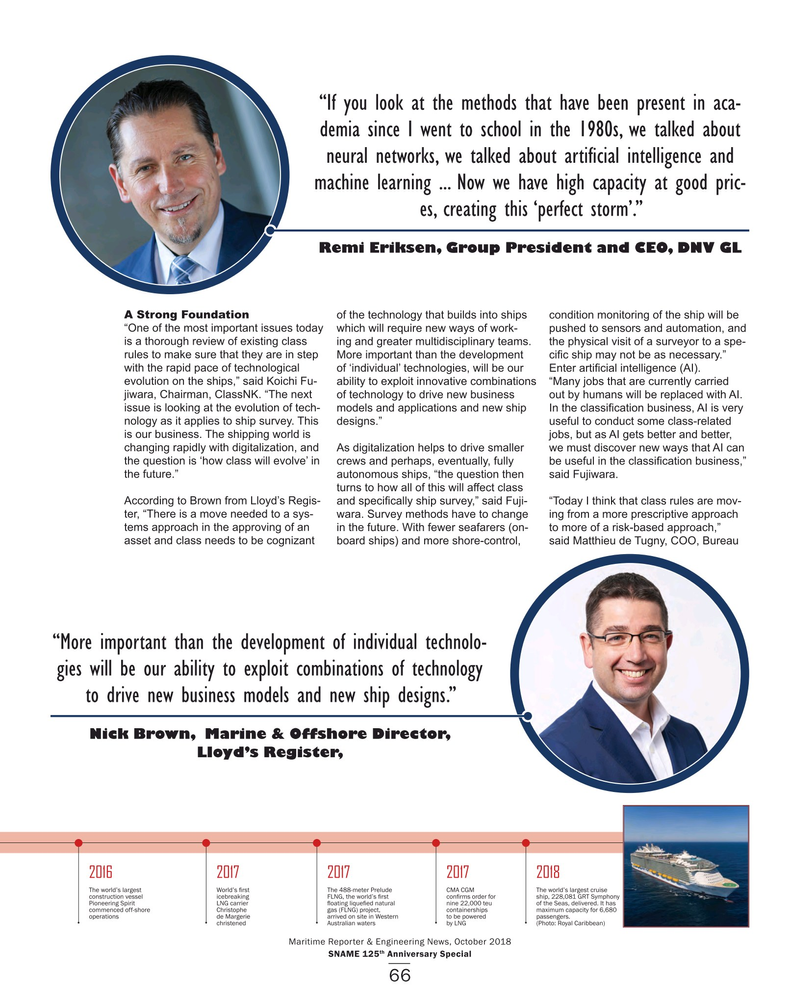
Page 66: of Maritime Reporter Magazine (October 2018)
Marine Design Annual
Read this page in Pdf, Flash or Html5 edition of October 2018 Maritime Reporter Magazine
“If you look at the methods that have been present in aca- demia since I went to school in the 1980s, we talked about neural networks, we talked about arti? cial intelligence and machine learning ... Now we have high capacity at good pric- es, creating this ‘perfect storm’.”
Remi Eriksen, Group President and CEO, DNV GL
A Strong Foundation of the technology that builds into ships condition monitoring of the ship will be “One of the most important issues today which will require new ways of work- pushed to sensors and automation, and is a thorough review of existing class ing and greater multidisciplinary teams. the physical visit of a surveyor to a spe- rules to make sure that they are in step More important than the development ci? c ship may not be as necessary.” with the rapid pace of technological of ‘individual’ technologies, will be our Enter arti? cial intelligence (AI).
evolution on the ships,” said Koichi Fu- ability to exploit innovative combinations “Many jobs that are currently carried jiwara, Chairman, ClassNK. “The next of technology to drive new business out by humans will be replaced with AI. issue is looking at the evolution of tech- models and applications and new ship In the classi? cation business, AI is very nology as it applies to ship survey. This designs.” useful to conduct some class-related is our business. The shipping world is jobs, but as AI gets better and better, changing rapidly with digitalization, and As digitalization helps to drive smaller we must discover new ways that AI can the question is ‘how class will evolve’ in crews and perhaps, eventually, fully be useful in the classi? cation business,” the future.” autonomous ships, “the question then said Fujiwara. turns to how all of this will affect class
According to Brown from Lloyd’s Regis- and speci? cally ship survey,” said Fuji- “Today I think that class rules are mov- ter, “There is a move needed to a sys- wara. Survey methods have to change ing from a more prescriptive approach tems approach in the approving of an in the future. With fewer seafarers (on- to more of a risk-based approach,” asset and class needs to be cognizant board ships) and more shore-control, said Matthieu de Tugny, COO, Bureau “More important than the development of individual technolo- gies will be our ability to exploit combinations of technology to drive new business models and new ship designs.”
Nick Brown, Marine & Offshore Director,
Lloyd’s Register, 2016 2017 2017 2017 2018
The world’s largest World’s ? rst The 488-meter Prelude CMA CGM The world’s largest cruise construction vessel icebreaking FLNG, the world’s ? rst con? rms order for ship, 228,081 GRT Symphony
Pioneering Spirit LNG carrier ? oating lique? ed natural nine 22,000 teu of the Seas, delivered. It has commenced off-shore Christophe gas (FLNG) project, containerships maximum capacity for 6,680 operations de Margerie arrived on site in Western to be powered passengers.
christened Australian waters by LNG (Photo: Royal Caribbean)
Maritime Reporter & Engineering News, October 2018 th
SNAME 125 Anniversary Special 66
MR #10 (66-73).indd 66 MR #10 (66-73).indd 66 10/8/2018 10:12:35 AM10/8/2018 10:12:35 AM

 65
65

 67
67
